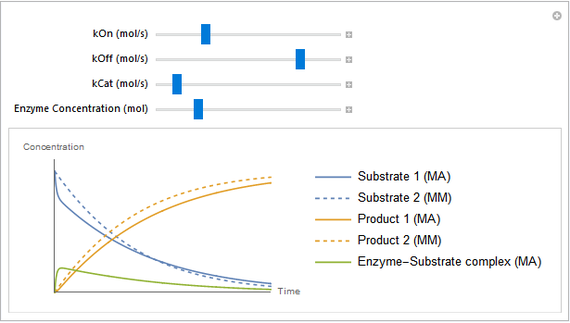計算生物学
生物系および生化学系をモデル化し,そのシミュレーションを実行し,可視化します.反応動力学もモデル化し,そのシミュレーションを実行します.
Michaelis–Menten Kinetics
A simple enzyme reaction that is not affected by negative feedback, allosteric effects or cooperativity can be simplified using Michaelis–Menten kinetics. This model aims to explain why this is. The free BioChem Modelica library is needed to run this example; it can be downloaded here.
Introduction
Michaelis–Menten kinetics is one of the most important models for enzyme-substrate interactions. It is used to study the kinetics in a wide array of biological functions, such as the immune response. While a mass action model of an enzyme-substrate interaction would go through an intermediate step with an enzyme-substrate complex, Michealis–Menten kinetics assumes that this complex rapidly enters quasi steady state and can be approximated. This eliminates the need to measure the formation rate of this complex, which is infeasible in practice.
The Model

The mass action model consists of four substances, while the Michaelis–Menten model only consists of two. Still, during certain circumstances, the behavior of the two models is nearly identical.
Visual Representation in SystemModeler
The model has been built in SystemModeler, which results in a visual representation of the model.
The enzyme and the enzyme-substrate complex are implied in the equilibrium description of substrate and product with the help of the Michaelis–Menten rate formula.
where
 Incorporates All Rate Constants
Incorporates All Rate Constants
The Michaelis constant consists of all three reaction rate constants of the regular mass action model, formulated to represent a net reaction flow.

 ,
,
which is called the Michaelis constant, where  ,
,  ,
,  are the constants for enzyme binding, product formation and substrate unbinding, respectively, as seen below.
are the constants for enzyme binding, product formation and substrate unbinding, respectively, as seen below.
E+S 

Simulation
The Model Comes to Life
Explore how the rate constants affect the reaction with dynamic sliders.
The model can be explored using the Manipulate functionality in the Wolfram Language. In the downloadable notebook, you can drag the sliders and see how the system responds.

Real-time changing of the values of the rate constants allows for experimentation and better understanding of the Michaelis–Menten formula and its associated constants, such as  and
and  .
.
 and
and  .
.Wolfram System Modeler
評価版
ご購入
System ModelerはWindows,macOS,
Linuxで
日本語と英語でご利用になれます »
ご質問やコメントはWolframエキスパートまでお寄せください »
